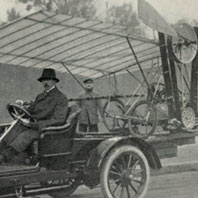TV Program Description
Original PBS Broadcast Date: November 7, 2006
In the early 1900s, the most acclaimed celebrity in Europe,
and arguably the world, was a fashionable, frail,
Brazilian-born aviator named Alberto Santos-Dumont. The first
to fly an airplane in Europe, Santos also built and flew the
first practical dirigibles, or powered balloons. At a period
when most balloons were at the mercy of the wind and many
still thought the airplane an impossibility, Santos's bold
exploits created a sensation. He was the spiritual father of
aviation, and at the same time, a flying P.T. Barnum,
intrepidly demonstrating his incredible flying machines in
Paris, London, New York, and St. Louis.
But Santos's burst of glory was short-lived. When the
secretive Wright brothers finally unveiled their flying
machine in France in 1908, Wilbur's piloting skills dazzled
the public and instantly eclipsed Santos's fame. Over the next
three decades, Santos slipped gradually into illness and
despair until he finally committed suicide, tormented by
knowing that the airplane, which he believed to be his
invention, had become a lethal weapon of war.
Based on the acclaimed biography by Paul Hoffman, "Wings of
Madness" tells the colorful and tragic life of this neglected
pioneer, a brilliant technical improviser who cut an
unforgettable figure of high fashion in turn-of-the-century
Paris. Always impeccably tailored, Santos delighted in
steering his airship down the boulevards and dropping in at
cafés or the garden parties of his wealthy friends,
while suffering numerous scrapes among the rooftops of Paris.
His friend Louis Cartier, the Parisian jeweler, created the
first wristwatch specifically so that Santos could keep track
of time while maneuvering his airship.
In the 1890s, Santos inherited a fortune from his Brazilian
coffee plantation-owning family and threw himself obsessively
into solving the challenge of flight. With characteristic
ingenuity, Santos figured out how to combine gasoline engines
with hydrogen balloons and avoid the explosions that everyone
predicted. A landmark, prize-winning flight around the Eiffel
Tower in 1901 turned him into an instant celebrity; the press
and public affirmed that mankind had indeed conquered the
skies.
Tiring of balloons, Santos built the 14bis, an ungainly
tail-first flying machine that nevertheless made the first
powered airplane flight in Europe in 1906. At that time, the
Wright brothers's secret early flights were widely
disbelieved, so Santos and his adoring public were convinced
he was the first to fly. When Wilbur made his triumphant
European tour in 1908, Santos had to face the terrible
realization that the Wrights were the true pioneers after all.
But just before his long slide into illness began, he designed
an exquisite new airplane out of bamboo: the
Demoiselle, or Damselfly. One of the classic aircraft
of the pioneering era, it was the true forerunner of today's
ultralight planes (see
Tale of the Damselfly
and
Tour the Demoiselle).
"Wings of Madness" combines captivating hands-on technology
with a human story of triumph and tragedy. The program
includes rare movie archive footage of Santos's original
flights as well as new footage of the recent building of a
14bis replica in Brazil. The hair-raising test flights
of this modern replica evoke the ingenuity and extreme courage
of Alberto Santos-Dumont as he pursued his lifelong dream of
flight.

Program Transcript
Program Credits


